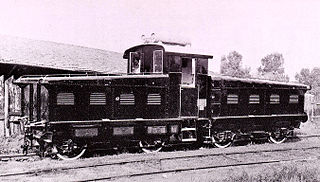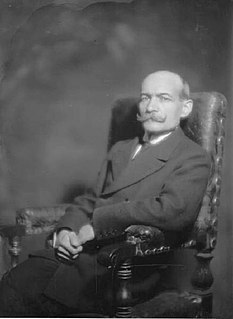
ABB Ltd, formerly ASEA Brown Boveri, is a Swedish–Swiss multinational corporation headquartered in Zürich, Switzerland, operating mainly in robotics, power, heavy electrical equipment, and automation technology areas. It is ranked 341st in the Fortune Global 500 list of 2018 and has been a global Fortune 500 company for 24 years. Until the sale of its electricity division in 2020, ABB was Switzerland's largest industrial employer. ABB is traded on the SIX Swiss Exchange in Zürich, Nasdaq Stockholm and the New York Stock Exchange in the United States.

ABB Daimler-Benz Transportation, commonly known under its brand ADtranz, was a multi-national rail transport equipment manufacturer with facilities concentrated in Europe and the US.

Bombardier TRAXX is a modular product platform of mainline diesel-electric and electric locomotives produced by Bombardier Transportation, which was built in both freight and passenger variants. The first version was a dual-voltage AC locomotive built for German railways from the year 2000. Later types included DC versions, as well as quadruple-voltage machines, able to operate on most European electrification schemes: 1.5/3.0 kV DC and 15/25 kV AC. The family was expanded in 2006 to include diesel-powered versions. Elements common to all variants include steel bodyshells, two bogies with two powered axles each, three-phase asynchronous induction motors, cooling exhausts on the roof edges, and wheel disc brakes.

Vado Ligure, in antiquity Vada Sabatia, is a town and comune in the province of Savona, Liguria, in northern Italy.

The E.412 class is a batch of multi-role electric locomotives built for the mountain lines, particularly for the northern Italian lines of the Brenner pass. They are known as Brenner or Brennerlok locomotives. 28 units from both the groups have been acquired by Trenitalia, as part of a process of simplifying rail operation between Italy, Switzerland, Austria and Germany. The locomotives are qualified for running on French rails, too, making the E.412s potentially fit for service on most European lines except the high-speed rail lines.

The E.464 is a class of Italian railways electric locomotives. They were introduced in the course of the 1990s for hauling light trains, especially for commuter service. They were acquired by FS Trenitalia to replace the old E.424 and E.646, dating from the 1940s and 1950s. The class was originally designed by ABB Trazione, later ADTranz, and produced in the Italian plant of Vado Ligure.
Strømmens Værksted A/S was an industrial company based in Skedsmo, Norway, specialising in the production of rolling stock. Founded in 1873, it remains as a part of Bombardier Transportation. The plant is located just off Hovedbanen west of Strømmen Station.
The Compagnia Generale di Elettricità S.p.A. was an Italian joint-stock company founded in 1921 in Milan. The company was widely know in Italy as simple acronym CGE, it was primarily owned and managed by General Electric USA.

The FS Class D.345 is a class of diesel-electric locomotive used in Italy, introduced in the 1970s and still in service.

The Mogadiscio-Villabruzzi Railway is an historical railway system that ran through southern Somalia. It was constructed between 1914 and 1927 by the colonial authorities in Italian Somaliland. The railway connected the capital city Mogadishu with Afgooye, and subsequently with Villaggio Duca degli Abruzzi - usually called "Villabruzzi". The line was later dismantled by British troops during World War II. Plans for re-establishing the railway were made in the 1980s by the Siad Barre administration, but were aborted after the regime's collapse.
The rail vehicle factory in Hennigsdorf, Germany, was founded in 1910 by AEG. Locomotive production began in 1913, and in the 1930s absorbed the work of the August Borsig locomotive factory, being renamed the Borsig Lokomotiv Werke GmbH until 1944. After the Second World War the factory was nationalised in the German Democratic Republic and produced electric locomotives for home use and for export, mainly to Communist Bloc countries under the name Lokomotivbau-Elektrotechnische Werke (LEW).

The FS Class E.320 was a class of Italian third rail electric locomotive built between 1915 and 1918. Five units were built and they saw service on the Varese - Milan - Porto Ceresio line. They were powered by two direct current electric motors, designed by Tecnomasio Italiano-Brown-Boveri (TIBB), giving a maximum speed of 95 km/h. The final assembly and the mechanical design were by Officine Meccaniche (OM). At the time of their construction they were the most powerful direct current locomotives in the world. The transmission of the motion to the three axles was by connecting rods and these were subject to frequent breakages.
The FS Class E.470 was an electric locomotive class of the state-owned Italian railway Ferrovie dello Stato. It was used on the Italian three-phase test line from Rome-Sulmona especially in express train service. After the end of the trial operation in 1945, the locomotives were scrapped, and no locomotive of the class has been preserved.
The Ferrovia Alta Valtellina (FAV) is a railway line in Italy which connects Sondrio, in Valtellina, to Tirano in Alta Valtellina. The railway company was established in 1899 and the line opened in 1902. Many railways in Italy were nationalized in 1905 but the Ferrovia Alta Valtellina escaped and was not nationalized until 1970.

The FS Class E.431 was a class of three-phase AC electric locomotives of the Italian State Railways (FS).

FS Class E.321 was a class of 17 third-rail electric locomotives, built for the Italian State Railways (FS) for operation on the Varese line and on the underground line in Naples.

The FS Class E.421 locomotive of the Italian State Railways (FS) was a battery electric locomotive, built as a single unit (E.421.1) and used for shunting at the old Milan Central railway station. It was the only battery electric locomotive to be registered in the FS fleet.

FAV Class E.440 was a class of four electric locomotives built for the Italian Ferrovia Alta Valtellina (FAV) in 1932 for the operation between Sondrio and Tirano.

Ercole Marelli was an Italian engineer and entrepreneur.













